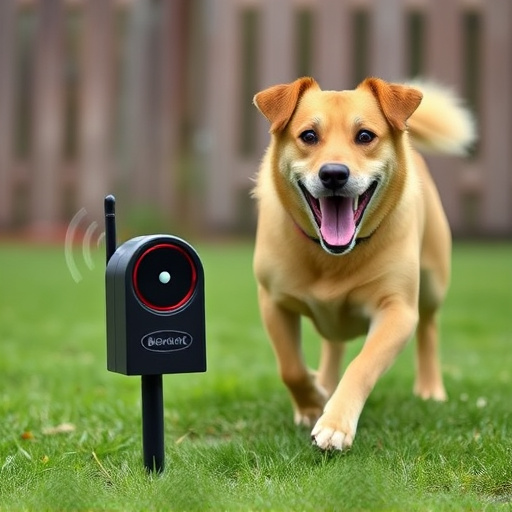Dog aggression, driven by fear or trauma, often requires innovative solutions beyond traditional deterrents. Ultrasonic pet deterrents emerge as a safe and effective option, leveraging inaudible high-frequency sound waves to trigger an instinctive aversion response in dogs without harming humans or other animals. Rigorous compliance testing is paramount to ensure these devices operate within safe hearing limits for dogs and deter unwanted behaviors effectively. This testing guarantees product reliability and peace of mind for pet owners seeking humane solutions, with the ultimate goal of promoting positive training outcomes and enhancing the well-being of both pets and their owners.
“Unleash a peaceful environment with an innovative solution—the ultrasonic dog deterrent. Addressing aggressive pet behavior is a priority for many owners, leading to the rise of effective alternatives. This article explores a modern approach to modifying canine aggression through ultrasonic technology. We delve into the science behind these devices, their effectiveness, and the crucial aspect of compliance testing to ensure safety and reliability. By understanding traditional deterrents and embracing new solutions, pet owners can find harmony with their furry companions.”
- Understanding Dog Aggression and Traditional Deterrents
- Introduction to Ultrasonic Dog Deterrent Devices
- How Does the Ultrasonic Technology Work?
- Compliance Testing for Dog Repellent Devices: Ensuring Safety and Effectiveness
Understanding Dog Aggression and Traditional Deterrents
Dog aggression can stem from various factors, including fear, territory protection, or past traumatic experiences. When left unaddressed, aggressive behavior can pose a significant risk to both pets and humans in close proximity. Traditional deterrents like loud noises, sprays, or physical corrections may provide temporary relief but often fail to resolve the root cause of aggression. These methods can also be inconsistent, requiring constant monitoring, and may even lead to negative reinforcement, exacerbating the behavior.
A more effective approach lies in utilizing a dog repellent device designed with advanced technology. Ultrasonic pet deterrents, for instance, emit high-frequency sound waves that are unpleasant to dogs but harmless to humans and other animals. Such devices have undergone rigorous compliance testing to ensure their safety and effectiveness. By targeting specific behaviors like barking or charging, these innovative tools offer a humane and reliable solution, promoting positive training outcomes and enhancing the overall well-being of both pets and owners.
Introduction to Ultrasonic Dog Deterrent Devices
Ultrasonic dog deterrents have emerged as a popular and non-violent solution for managing aggressive pet behavior. These devices emit high-frequency sound waves that are inaudible to humans but can be detected by dogs, triggering an instinctive aversion response. The technology is designed to discourage unwanted behaviors like barking, jumping, or aggression without causing harm.
Compliance testing plays a crucial role in ensuring these dog repellent devices operate safely and effectively. Rigorous testing protocols verify that the ultrasonic frequencies fall within safe hearing limits for animals, preventing any potential harm. Moreover, these tests assess the device’s overall performance, including its sensitivity, range, and consistency in deterring canine behavior. By undergoing such evaluations, manufacturers guarantee the reliability and quality of their products, offering peace of mind to pet owners seeking humane solutions for their aggressive pets.
How Does the Ultrasonic Technology Work?
Ultrasonic technology used in dog deterrent devices operates on a simple yet effective principle. These devices emit high-frequency sound waves that are inaudible to humans but irritating to dogs. The sound is produced by a small transducer within the device, which converts electrical energy into ultrasonic vibrations. These vibrations travel through the air and are perceived by a dog’s sensitive hearing as a constant, annoyingly loud noise.
Compliance testing for these dog repellent devices is crucial to ensure their effectiveness and safety. Rigorous testing protocols verify that the ultrasonic sound falls within the appropriate frequency range (typically 25-64 kHz) that targets dogs without causing harm or discomfort to humans or other animals. This ensures not only the device’s ability to deter aggressive behavior but also its ethical use as a pet care solution.
Compliance Testing for Dog Repellent Devices: Ensuring Safety and Effectiveness
Dog repellent devices, especially those using ultrasonic technology, need rigorous testing to ensure their safety and effectiveness. Compliance testing is a crucial step in validating that these devices meet industry standards and are suitable for use with pets. This process involves evaluating various aspects, including sound pressure levels (to prevent harm to the pet’s hearing) and frequency ranges (to target specific dog behaviors without affecting humans or other animals).
By undergoing compliance testing, manufacturers demonstrate that their products not only deter aggressive behaviors but also adhere to strict safety guidelines. It’s a vital step in ensuring the well-being of pets and providing peace of mind for owners who seek non-lethal solutions for managing their dogs’ aggression. This testing plays a significant role in the responsible development and marketing of dog repellent devices, ultimately guiding consumers towards effective and safe options.
The ultrasonic dog deterrent represents a modern, non-violent approach to addressing aggressive pet behavior. By understanding the science behind this technology and adhering to strict compliance testing for dog repellent devices, pet owners can find a safe and effective solution. Incorporating these innovative tools into training regimens demonstrates a commitment to positive reinforcement, ultimately fostering healthier relationships between pets and their caregivers. When used responsibly, ultrasonic dog deterrents offer a promising path forward in managing canine aggression, enhancing the well-being of both animals and their human companions.
